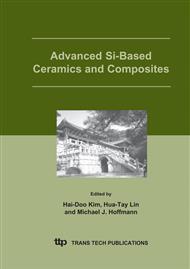p.335
p.340
p.346
p.352
p.358
p.367
p.381
p.393
p.404
Toughening of Ceramic Composite Designed by Silica-Based Transformation Weakening Interphases
Abstract:
A new concept for achieving graceful failure in oxide composites is introduced. It is based on crack deflection in a weak interphase between a matrix and reinforcement (e.g. fiber), or in a laminated composite. The interphase can be phase transformation weakened by volume contraction and/or unit cell shape change. Microcracking induced by a displacive, crystallographic phase transformation in silica-based interphases resulted in increase in the toughness of the bulk composites. In the present study, mullite/cordierite laminates with b®a-cristobalite (SiO2) transformation weakened interphase, and alumina matrix fibrous monolith with metastable hexacelsian (BaAl2Si2O8) interphases were investigated for interphase debonding behavior. In mechanical test, the laminates showed step-wise load drop behavior dependent on a grain size of b-cristobalite. In particular, in the fibrous monolith design, the load-deflection curve showed unusual plastic-like behavior with reasonable work of fracture.
Info:
Periodical:
Pages:
358-366
Citation:
Online since:
June 2005
Authors:
Keywords:
Price:
Сopyright:
© 2005 Trans Tech Publications Ltd. All Rights Reserved
Share:
Citation:


